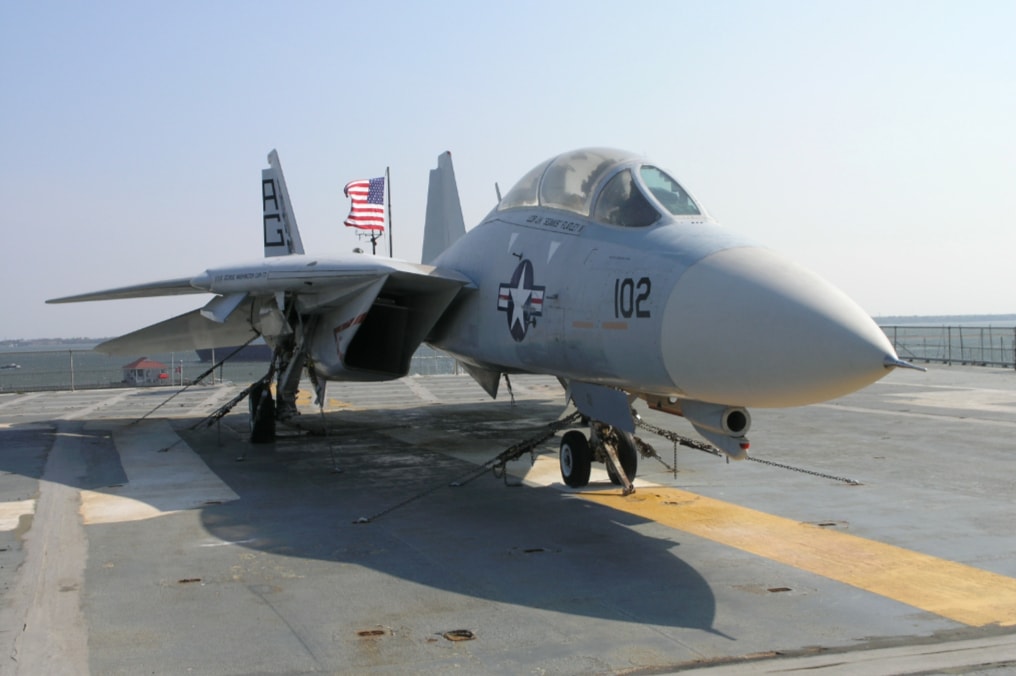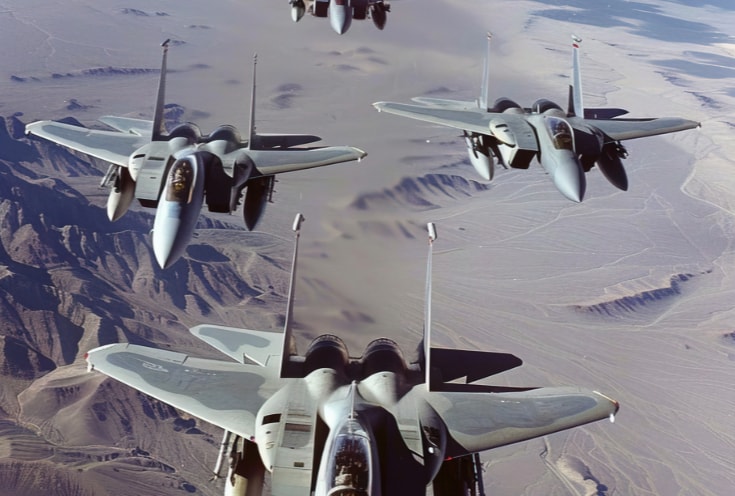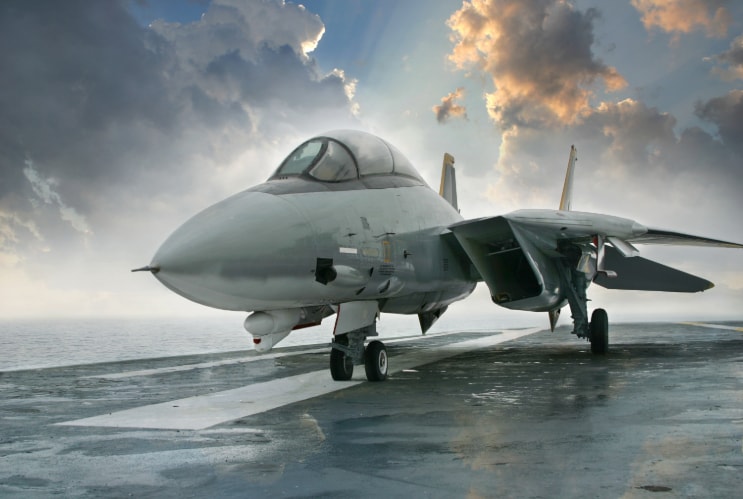F-14 Tomcat: America's Legendary Fighter Aircraft
The F-14 Tomcat, an iconic U.S. Navy fighter, flew from 1974 to 2006. Famous for its swing-wing design and powerful engines, it defined American air superiority. In this article, we explore its creation, features, combat service, and lasting legacy.
Key Takeaways
-
The F-14 Tomcat was developed as a response to the F-111B project’s inadequacies, serving as a versatile and advanced naval air defense fighter from its introduction in 1974 until its retirement in 2006.
-
Innovative features such as variable-sweep wings, twin engines, and advanced avionics made the F-14 a formidable multirole aircraft, excelling in both air-to-air combat and ground attack roles.
-
The F-14’s legacy is cemented through its notable combat engagements during the Cold War and the Gulf War, as well as its iconic status in popular culture, particularly due to its portrayal in the film ‘Top Gun.’
The Birth of the F-14 Tomcat

The F-14 Tomcat’s journey began with the Naval Fighter Experimental (VFX) program, a direct response to the inadequacies faced during the F-111B project. The failure of the F-111B underscored the need for a more advanced and versatile aircraft capable of meeting the U.S. Navy’s stringent requirements for fleet air defense and long-range interception. This need birthed the Grumman F-14 Tomcat, a fighter designed to dominate the skies and secure American naval supremacy.
The F-14 made its maiden voyage on December 21, 1970, a significant milestone that took place during its early testing phases over Long Island Sound. Manufactured by the Grumman Corporation at facilities in Calverton and Bethpage, New York, the production spanned from 1969 to 1991, yielding a total of 712 aircraft. This extensive production run highlighted the aircraft’s importance and the confidence placed in its capabilities by the U.S. Navy.
Engineered with a service life of 6,000 flight hours, the F-14 was built to endure the rigors of combat and the demanding conditions of carrier operations. Its robust design and extensive testing ensured that it would be a reliable asset in the Navy’s arsenal, ready to meet any challenge posed by enemy aircraft or maritime threats.
Key Features and Design Innovations
The F-14 Tomcat was a marvel of engineering, incorporating several groundbreaking design features that set it apart from its predecessors. Its variable-sweep wings, twin engines, and advanced avionics made it a versatile aircraft, capable of excelling in both air-to-air combat and ground attack missions.
These innovations ensured that the F-14 could adapt to a wide range of combat scenarios, providing the U.S. Navy with a formidable tool for maintaining air superiority and fleet defense.
Variable Geometry Wings
One of the most distinctive features of the F-14 Tomcat is its variable geometry wings, which could be swept between 20° and 68° to optimize aerodynamic performance for different flight conditions. This unique design allowed the F-14 to maintain exceptional maneuverability and stability at both high and low speeds, making it a formidable opponent in dogfights and a reliable platform for carrier operations.
These wings, also known as swing wings, were integral to the F-14’s ability to perform a wide range of missions effectively. Adjusting the variable sweep wing allowed pilots to maximize lift during takeoff and landing on aircraft carriers and achieve high-speed performance during combat engagements. This versatility was crucial for adapting to the dynamic demands of naval aviation, ensuring that the F-14 remained a dominant force in aerial combat.
Twin Engine Power
The F-14’s power came from its twin-engine configuration, originally featuring the TF30 engines and later upgraded to the F110-GE-400 engines. The dual-engine setup enabled the F-14 to reach speeds exceeding Mach 2, providing the necessary thrust to swiftly intercept and engage enemy aircraft. Upgrading to the F110-GE-400 engines significantly improved performance, enhancing both the aircraft’s reliability and combat effectiveness.
Equipped with twin Pratt & Whitney engines, the F-14 Tomcat boasted remarkable speed and agility, essential for its role as a fleet defender and air superiority fighter. These advancements ensured that the F-14 could maintain a competitive edge in various combat scenarios, meeting the evolving challenges of modern aerial warfare.
Advanced Avionics and Flight Controls
The F-14 Tomcat was equipped with state-of-the-art avionics and flight control systems that significantly enhanced its combat capabilities. At the heart of these systems was the Hughes AN/AWG-9 X band radar, capable of tracking multiple targets simultaneously, providing pilots with crucial situational awareness during engagements.
The F-14’s cockpit included a heads-up display (HUD) projecting vital flight and targeting information directly in the pilot’s line of sight. This allowed pilots to keep their focus on the battlefield without needing to glance down at their instruments, improving their reaction times and effectiveness in combat.
Additionally, the tandem seating arrangement enabled effective coordination between the pilot and the radar intercept officer (RIO), further enhancing the aircraft’s operational efficiency.
Armament and Combat Capabilities

The F-14 Tomcat was designed to be a formidable force in both air-to-air and ground attack roles, making it a versatile aircraft in the U.S. Navy’s arsenal. Its advanced weaponry, including the AIM-54 Phoenix missile, allowed it to engage multiple enemy targets at long ranges, securing air superiority and providing robust fleet air defense.
Air-to-Air Combat
Equipped for air-to-air combat, the F-14 Tomcat carried a formidable array of weaponry, including a 20-mm cannon and a combination of AIM-7 Sparrow, AIM-9 Sidewinder, and AIM-54 Phoenix missiles. This diverse armament allowed the F-14 to engage enemy aircraft at various ranges, ensuring that it could neutralize threats before they could endanger the fleet.
The F-14’s ability to carry up to six AIM-54 Phoenix missiles was particularly noteworthy, as these missiles could engage targets over 90 miles away, a capability unmatched by any other U.S. aircraft at the time. This long-range interception capability made the F-14 an essential asset for maintaining air superiority during the Cold War and beyond.
Ground Attack Upgrades
In the 1990s, the F-14 Tomcat underwent significant upgrades to enhance its ground attack capabilities. Modifications integrated laser-guided bombs and other precision-guided munitions, enabling the F-14 to conduct precise strikes against ground targets.
This evolution transformed the f 14a from a purely air superiority fighter into a versatile multirole aircraft capable of performing a wide range of combat missions.
Defensive Systems
The F-14 Tomcat was equipped with advanced defensive systems to protect it from enemy threats. These included electronic countermeasures (ECM) and a radar warning receiver (RWR) that helped detect and evade incoming missiles. These systems provided a comprehensive defense against a variety of aerial threats, enhancing the F-14’s overall survivability in combat scenarios.
Working in tandem, the ECM and RWR systems created a robust defensive network, ensuring the F-14’s safe operation in hostile environments. This combination of offensive and defensive capabilities made the F-14 a formidable opponent in any combat situation.
Operational History and Notable Engagements
The F-14 Tomcat’s operational history is marked by numerous notable engagements and missions that showcased its capabilities. From its introduction to the U.S. Navy in 1974 to its retirement in 2006, the F-14 played a crucial role in various military operations, demonstrating its versatility and effectiveness in combat.
Early Service and Cold War Operations
Replacing the aging F-4 Phantom II, the F-14 Tomcat enhanced the U.S. Navy’s air power during the Cold War. Its early service included the evacuation of American citizens from Saigon during Operation Frequent Wind in 1975, marking its first combat mission. Throughout the Cold War, F-14s routinely intercepted Soviet bombers like the Tu-95, protecting U.S. carrier groups and maintaining a strategic advantage over the Soviet Union.
Early operations underscored the F-14’s capabilities as a long-range interceptor and air superiority fighter, proving its value in safeguarding American interests during a tense global period.
Gulf of Sidra Incidents
The Gulf of Sidra incidents in 1981 marked the F-14’s first combat engagement, where it achieved the first aerial combat victories for the U.S. Navy since the Vietnam War. During this confrontation, F-14s shot down two Libyan Su-22 fighters, demonstrating their combat effectiveness and solidifying their reputation as formidable air superiority fighters.
Gulf War Contributions
The F-14 played a significant role in the Gulf War, participating in both air-to-air combat and reconnaissance missions. Equipped with the Tactical Airborne Reconnaissance Pod System (TARPS), the F-14 provided critical reconnaissance capabilities, gathering valuable intelligence for military operations. These contributions were crucial for achieving air superiority and supporting ground forces during the conflict.
Throughout the Gulf War, the F-14’s versatility and advanced technology enabled it to perform a wide range of missions, from enforcing no-fly zones to conducting precision strikes. Its performance during the war highlighted its enduring value as a multirole fighter and a key asset in the U.S. Navy’s arsenal.
Carrier Operations and Fleet Defense

Operating from aircraft carriers, the F-14 Tomcat was integral to the U.S. Navy’s combat air patrol (CAP) and fleet air defense missions. Its ability to launch and recover at sea made it a crucial component of carrier operations, ensuring that the fleet remained protected from enemy threats, including the aircraft carrier.
Role in Carrier Operations
Specialized take-off and landing procedures enabled the F-14 to operate effectively from aircraft carriers. These procedures included the use of catapults for launch and tailhooks for recovery, enabling the F-14 to perform seamlessly in the demanding environment of carrier operations. The landing gear was engineered to withstand the stresses of carrier take-offs and landings, ensuring reliability and safety.
During the Gulf War, F-14s were instrumental in enforcing no-fly zones and conducting reconnaissance missions, showcasing their versatility and importance in carrier operations. With a total of 4,124 sorties flown, the F-14’s contributions to air superiority and reconnaissance missions were invaluable.
Combat Air Patrol and Fleet Air Defense
The F-14’s primary role in combat air patrol (CAP) missions involved monitoring and defending the airspace around carrier groups. Its advanced radar and missile systems allowed it to detect and engage threats before they could reach the fleet, providing a crucial layer of defense. The F-14’s long-range capabilities were essential for intercepting enemy aircraft and missiles, ensuring the safety of the carrier group.
Advanced avionics, long-range interception capabilities, and effective CAP strategies made the F-14 an indispensable asset for fleet air defense. Its ability to track multiple aerial threats simultaneously and neutralize them before they posed a danger underscored its role as a premier fleet defender.
Modernization Efforts and Legacy

The F-14 Tomcat underwent several modernization efforts throughout its service life to maintain its competitive edge. These upgrades, along with its storied history and cultural impact, have cemented its legacy as one of the most iconic fighter aircraft in aviation history.
Upgrades and Improvements
The F-14 Tomcat saw numerous upgrades aimed at enhancing its performance and extending its operational life. One significant improvement was the introduction of the F110-GE-400 engine, providing better thrust and reliability than the original TF30 engines. This upgrade not only enhanced the aircraft’s speed but also improved its overall combat effectiveness, making it more capable in various operational scenarios.
Additionally, the F-14 was equipped with a Digital Flight Control System (DFCS), which dramatically improved its handling characteristics, especially during combat situations. These enhancements, along with upgraded avionics and cockpit displays for precision munitions, transformed the F-14 into a formidable multirole aircraft.
Although the F-14D was set to receive AIM-120 AMRAAM missile capability, this upgrade was ultimately canceled.
Retirement and Replacement
The F-14 Tomcat was officially retired from U.S. Navy service on September 22, 2006, marking the end of an era for this iconic fighter. The decision to retire the F-14 was influenced by several factors, including the high costs of maintenance and the shift in focus towards modern asymmetrical warfare. New threats and advancements in aviation technology rendered the F-14 less relevant in the evolving combat environment.
The F/A-18 Hornet and later the F-35 Lightning II were selected as the replacements for the F-14 Tomcat, offering advanced avionics, multi-role capabilities, and reduced operational costs.
However, despite its retirement, the legacy of the F-14 continues to be honored in naval aviation, and its iconic status remains influential in both military and popular culture.
Cultural Impact and Media Appearances

The F-14 Tomcat has achieved iconic status in popular culture, symbolizing naval aviation and American military power. Its representation in various forms of media has cemented its place in the public’s imagination, making it one of the most recognizable fighter aircraft in history.
Top Gun and Pop Culture
The F-14’s role in the 1986 blockbuster film ‘Top Gun’ catapulted it to stardom, showcasing its exceptional agility and performance in thrilling aerial combat sequences. The film not only highlighted the advanced capabilities of the F-14 but also contributed to its legendary status as a premier fighter aircraft. The portrayal of the F-14 in ‘Top Gun’ has left an indelible mark on popular culture, associating the aircraft with naval aviation prowess and heroism.
Portrayed in ‘Top Gun,’ the F-14 Tomcat became a beloved aircraft in the public’s imagination, symbolizing the skill and bravery of its pilots. This cultural impact has ensured that the F-14 remains a celebrated icon, long after its retirement from active service.
Museums and Displays
Numerous F-14 Tomcats are preserved at military installations and aviation museums worldwide, showcasing their historical significance and celebrating their role in American aviation history. Notable displays include the National Museum of Naval Aviation in Pensacola, Florida, and the Intrepid Sea-Air-Space Museum in New York, where visitors can learn about the F-14’s storied past and its contributions to naval aviation.
These displays not only commemorate the F-14’s legacy but also serve as educational resources, inspiring future generations to appreciate the advancements in aviation technology and the valor of those who flew these remarkable aircraft.
Museums such as the USS Midway Museum in San Diego and the Cradle of Aviation Museum in Garden City, New York, offer visitors a chance to witness the F-14 up close and understand its impact on military aviation.
Summary
The F-14 Tomcat’s legacy is one of innovation, versatility, and excellence in combat. From its inception through the VFX program to its iconic status in popular culture, the F-14 has left an indelible mark on both military aviation and public imagination. Its advanced design features, including variable geometry wings, twin engines, and state-of-the-art avionics, set new standards for fighter aircraft.
The operational history of the F-14 Tomcat is replete with notable engagements and significant contributions to U.S. military operations, particularly during the Cold War and the Gulf War. Despite its retirement in 2006, the F-14’s influence endures, celebrated in museums and immortalized in media. The F-14 Tomcat remains a testament to the ingenuity and dedication of those who designed, built, and flew this legendary aircraft.
Frequently Asked Questions
What was the primary role of the F-14 Tomcat?
The primary role of the F-14 Tomcat was to function as an air superiority fighter and long-range naval interceptor, effectively engaging multiple enemy targets with its advanced weaponry.
When did the F-14 Tomcat first enter service?
The F-14 Tomcat first entered service with the U.S. Navy in September 1974. It was subsequently deployed aboard the USS Enterprise.
What made the F-14's variable geometry wings unique?
The F-14's variable geometry wings are unique because they can sweep between 20° and 68°, allowing for optimized aerodynamic performance that enhances both maneuverability and speed in various flight conditions.
How did the F-14 contribute to the Gulf War?
The F-14 significantly contributed to the Gulf War by excelling in air-to-air combat and conducting reconnaissance missions with the Tactical Airborne Reconnaissance Pod System (TARPS), which provided essential intelligence. This dual capability underscored its effectiveness in the conflict.
Why was the F-14 Tomcat retired?
The F-14 Tomcat was retired primarily due to high maintenance costs and the need for more advanced and versatile aircraft, such as the F/A-18 Hornet and F-35 Lightning II, to meet modern asymmetric warfare demands. There was a Super Tomcat design that was explored but it lost out to the F-18.







